| Columns Retired Columns & Blogs |
Krell KSA-300S power amplifier Measurements
Sidebar 2: Measurements
Following the 1/3-power, one-hour preconditioning test, the KSA-300S's heatsinks were hot, though not too hot to touch. Interestingly, though it was driving only 100W into 8 ohms during this test, the bias level 3 lights came on. This was somewhat surprising, since the owner's manual indicates approximately 75% rated power for this bias level (225W into 8 ohms). Checking the precise point at which the bias-level lights illuminated, I obtained approximately 100mW for level 1 (113mW left, 97mW right), 17W for level 2, 84W for level 3, and 253W for level 4. (There were some interchannel differences, but these were only worth noting at level 1.) This is considerably different from the levels referenced in the owner's manual. Practically speaking, it means that, into a hypothetically ideal 8 ohm load, the second bias level, for example, will operate from 17W to 84W, the third from 84W to 254W, and the fourth above 254W.
The KSA-300S's input impedance measured 47k ohms unbalanced, and just under 91k ohms balanced. The amplifier's output impedance measured 0.13–0.14 ohms at 1kHz, 20Hz, and 20kHz. Voltage gain into 8 ohms measured 25.6dB. DC offset, though fluctuating slowly with time, was a maximum of about 3.5mV (L) and 1.9mV (R). Signal/noise (unweighted ref. 1W into 8 ohms) measured 95.8dB in the balanced mode. The KSA-300S is noninverting, unbalanced; balanced, pin 2 is configured as the positive leg, pin 3 the negative.
Fig.1 shows the frequency response of the 300S driven from its balanced inputs at 1W into 8 ohms. The response into 4 ohms, and from the unbalanced inputs, is not shown, but was virtually the same. The waveform of a 10kHz squarewave in the balanced mode (fig.2) shows only a small rounding of the leading edge. The 1kHz squarewave (not shown) was virtually textbook-perfect.
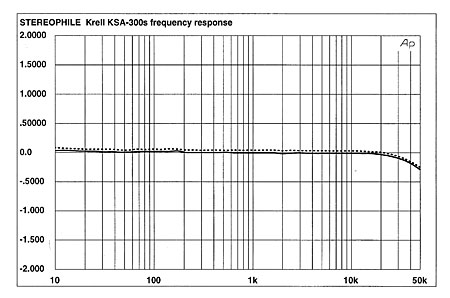
Fig.1 Krell KSA-300S, balanced mode, frequency response at 1W into 8 ohms (right channel dashed, 0.5dB/vertical div.).

Fig.2 Krell KSA-300S, 10kHz squarewave at 1W into 8 ohms.
The crosstalk shown in fig.3 indicates nearly identical performance in either balanced or unbalanced configurations. The balanced right-to-left crosstalk is marginally better across most of the range than any of the other readings, and the unbalanced crosstalk trace rises at the second harmonic of the power-line frequency, indicating the presence of very–low-level 120Hz hum. But in general, either mode offers very good separation.
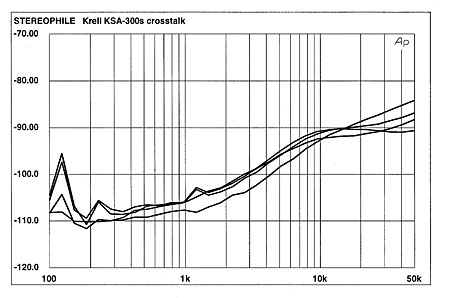
Fig.3 Krell KSA-300S, crosstalk (from top to bottom at 50kHz): R–L, balanced (bottom at 1kHz); L–R balanced; R–L, unbalanced (top, 100–400Hz); L–R unbalanced (10dB/vertical div.).
The THD+noise vs frequency for the balanced mode—the unbalanced mode, not shown, is a virtual overlay of these graphs—is plotted in fig.4. While the results are not exceptionally low, and rise at high frequencies (fairly common), low frequencies (less common with solid-state amplifiers), and lower impedances, they are nonetheless good, and consistent with a high-end amplifier designed for more than just eye-popping test-bench performance.
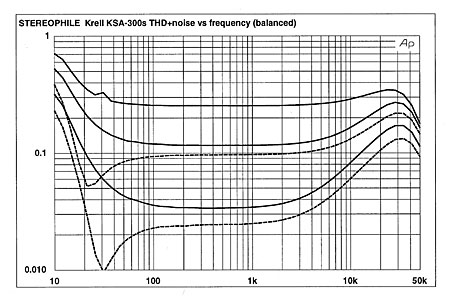
Fig.4 Krell KSA-300S, THD+noise vs frequency at (from top to bottom): 4W into 2 ohms, 2W into 4 ohms, and 1W into 8 ohms (right channel dashed).
The 1kHz distortion waveform (2W into 4 ohms) in fig.5 shows a large second-harmonic component combined with some higher-order harmonics and noise. These higher-order harmonics are increasingly evident into 2 ohms (at 4W), resulting in an increasingly triangular waveform (fig.6). The largely second-order nature of the distortion, however, remains.
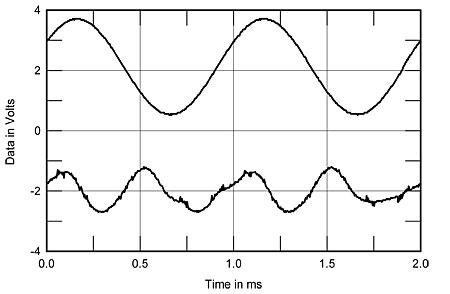
Fig.5 Krell KSA-300S, 1kHz waveform at 2W into 4 ohms (top); distortion and noise waveform with fundamental notched out (bottom).
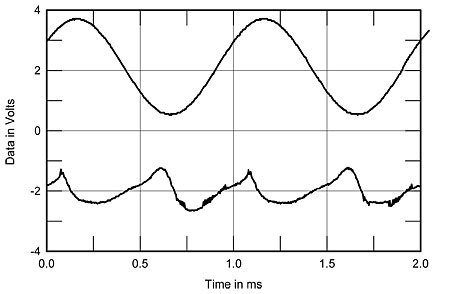
Fig.6 Krell KSA-300S, 1kHz waveform at 4W into 2 ohms (top); distortion and noise waveform with fundamental notched out (bottom).
The KSA-300S's output spectrum, driving a 50Hz tone at 400W into 4 ohms (2/3 rated power at that load) is shown in fig.7. While not as low as in some amplifiers measured recently, the distortion components here are still all at or below 0.1% (–60dB). At this high level, the third harmonic has risen to the same level as the second. Fig.8 shows the output spectrum of a combined 19+20kHz signal—the intermodulation products resulting from an input signal consisting of an equal combination of these two frequencies—at 331W into 4 ohms. The largest artifacts here are at 18kHz and 21kHz (–55dB, or 0.17%), with the next largest at 1kHz (–59.6dB, or just over 0.1%). The 19+20kHz artifacts at 170W into 8 ohms (not shown) were very similar but just slightly lower. In both cases, the specified output power was the power just prior to visible waveform clipping with this signal.
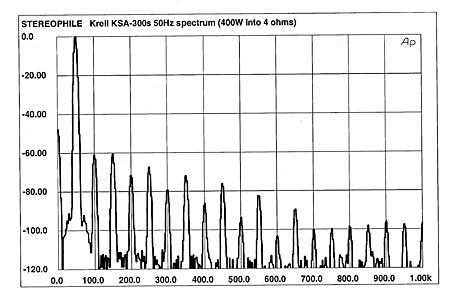
Fig.7 Krell KSA-300S, spectrum of 50Hz sinewave, DC–1kHz, at 400W into 4 ohms (linear frequency scale). Note that the second and third harmonics, at 100Hz and 150Hz, are the highest in level, 60dB below the level of the 50Hz fundamental (0.1%).
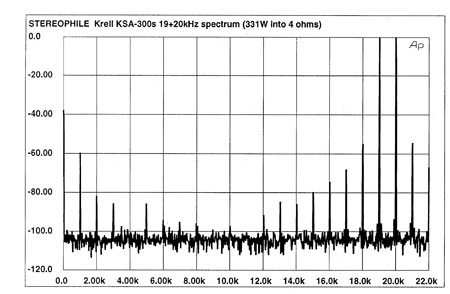
Fig.8 Krell KSA-300S, HF intermodulation spectrum, DC–22kHz, 19+20kHz at 331W into 4 ohms (linear frequency scale, 0dB = –6dBr).
The 1kHz, THD+noise vs level curves for the KSA-300S are shown in fig.9. These plots are a little unusual in that the distortion rises to a moderate value somewhere below 10W, then remains at that value until reaching the knee of the curve, just prior to clipping. The KSA-300S's discrete clipping levels (at 1% THD+noise) are shown in Table 1.

Fig.9 Krell KSA-300S, distortion vs output power into (from bottom to top): 8 ohms, 4 ohms, and 2 ohms.
Table 1: Krell KSA-300S Clipping (1% THD+noise at 1kHz)
| Both channels driven | One channel driven | ||
| Load | W(dBW) | W(dBW) | |
| (ohms) | (L) | (R) | (L) |
| 8 | 331 (25.2) | 330.7 (25.2) | 365.1 (25.6) |
| (line voltage) | 113V | 115V | |
| 4 | 570 (24.6) | 570.7 (24.6) | 669.8 (25.3) |
| (line) | 111V | 114V | |
| 2 | 1114 (24.5) | ||
| (line) | 113V | ||
The slightly low line voltage may explain the marginally lower-than-spec power output into a 2 ohm load, as well as the slightly higher-than-spec THD+noise at rated power visible in fig.9. We do not use Variacs or other devices to control the line voltage in our bench tests, preferring to let the equipment operate from the line in the way it routinely will in normal use.
These are very fine bench-test results. While not the absolute best we have ever measured, there is nothing here which would compromise the KSA-300S's audible performance in any way.—Thomas J. Norton
- Log in or register to post comments




































